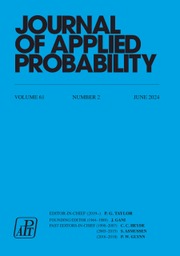Article contents
Hitting probabilities for random ellipses and ellipsoids
Published online by Cambridge University Press: 14 July 2016
Abstract
Let  denote a rectangular lattice in the Euclidean plane E 2, generated by (a × b) rectangles. In this paper we consider the probability that a random ellipse having main axes of length 2α and 2ß, with
denote a rectangular lattice in the Euclidean plane E 2, generated by (a × b) rectangles. In this paper we consider the probability that a random ellipse having main axes of length 2α and 2ß, with  intersects
intersects  . We regard the lattice
. We regard the lattice  as the union of two orthogonal sets
as the union of two orthogonal sets  and
and  of equidistant lines and evaluate the probability that the random ellipse intersects
of equidistant lines and evaluate the probability that the random ellipse intersects  or
or  . Moreover, we consider the dependence structure of the events that the ellipse intersects
. Moreover, we consider the dependence structure of the events that the ellipse intersects  or
or  . We study further the case when the main axes of the ellipse are parallel to the lines of the lattice and satisfy 2ß = min (a, b) < 2α = max (a, b). In this case, the probability of intersection is 1, and there exist almost surely two perpendicular segments in
. We study further the case when the main axes of the ellipse are parallel to the lines of the lattice and satisfy 2ß = min (a, b) < 2α = max (a, b). In this case, the probability of intersection is 1, and there exist almost surely two perpendicular segments in  within the ellipse. We evaluate the distribution function, density, mean and variance of the length of these segments. We conclude with a generalization of this problem in three dimensions.
within the ellipse. We evaluate the distribution function, density, mean and variance of the length of these segments. We conclude with a generalization of this problem in three dimensions.
Keywords
MSC classification
Information
- Type
- Short Communications
- Information
- Copyright
- Copyright © Applied Probability Trust 1993
References
- 5
- Cited by

